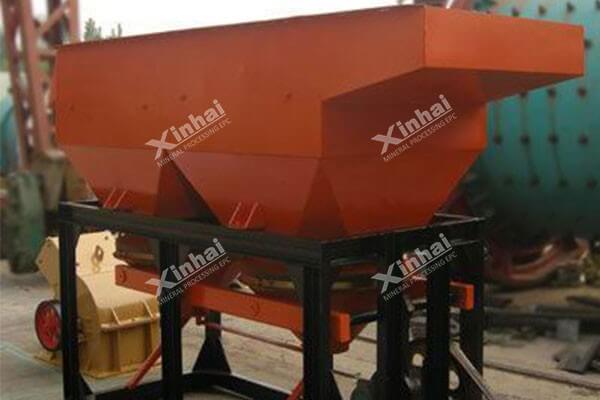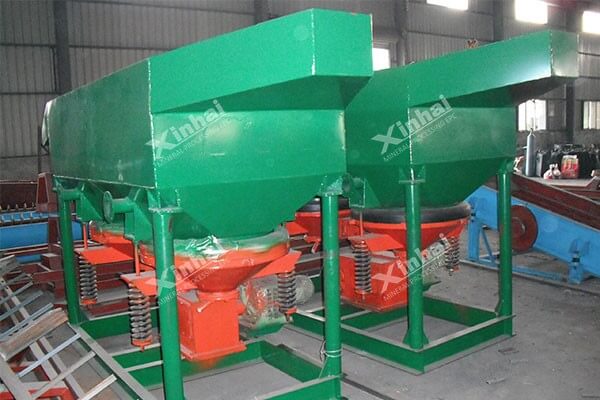

The Ultimate Guide for Jigs
2019-08-26 15:02:16xinhai
The jig is one of the common gravity separation equipment, which uses the material to be sorted according to the density difference in the variable speed medium for vertical lifting.
In the early stage of the construction of the jigging gravity concentrator, the specifications and types of jigging equipment used should be comprehensively considered according to the demand for processing materials, recovery index and investment costs and other factors.The mine owners can consult the manufacturers of the equipment with the design qualification of the concentrator, and should not choose blindly on their own, to avoid losses.

The beneficiation medium of the jig can use water or air. The use of water beneficiation is called hydraulic jigging, and the use of air beneficiation is called air jigging.

There are many factors that can affect the jigging classification indexes, including material properties, mechanical structure and operation factors. Among them, stroke, stroke number, amount of additional water under screen, composition of artificial bed and amount of ore feed can be adjusted in the production process. Although the size and density composition of feed ore, the form of jump cycle line and other factors also affect the jig separation, it is not easy to adjust in the production process.
The stroke and jig frequency can directly influence the porosity and dispersing mode of jig bed as the most important parameters on the jig separation process which has great influence on the stratification. With large stroke, the jig bed has a higher lifting effect and a larger loose space; With high jig frequency, the bed can maintain a shorter loose time, but at the same time, the stratified speed is faster. Therefore,only choose the appropriate stroke and jig frequency can we achieve a suitable loose stratification.
Due to the different requirement of the material property, the operating conditions and the final product, the requirement of stroke and jig frequency are not the same. We need to determine them by test in the trial run. In practical production, the jig operator is required to check and adjust the looseness of the bed at any time by changing the amount of hutch water. The commonly used matching system in production is large strokes & low jig frequency and small strokes & high jig frequency.
When the density of the feeding material is large, the particle size is coarse or the thickness of the jig bed is large, the jig capacity is large, and the concentrate yield is large, it is preferable to use a large stroke and low jig frequency. In contrast, the separation of fine-grained materials should be using a small stroke and high jig frequency. In addition, we should use a large stroke when the hutch water flow is small.
The total amount of water used in jig dressing fluctuates between 3 and 8m3/t depending on the different ore characteristics and the equipment used.
The feed water is pre-wetted ore to facilitate uniform feeding.
Additional water is added under the sieve to supplement the amount of water consumed with the discharge of tailings, which can also control the quantity and quality of the concentrate discharged under the sieve by adjusting the looseness of the bed and reducing the suction effect of excessive descending water.
Adding water under the screen is the main method to adjust the bed looseness during production, which should be controlled at any time according to bed looseness, fine mineral yield and quality requirements.
The bed thickness mainly affects the looseness of ore and the stratification rate of ore particles in the jig. Two jig beds can speed up the stratification rate and increase the production capacity of the ore with great difference in mineral density between the useful minerals and gangue. The higher of quality requirement, the thicker of the jig bed. Jig bed thickness can be calculated by using the height between the screen surface and the tailings plate.
When dealing with the medium or fine-grained ore by diaphragm jig, the total thickness of bed shall not be less than 5~10 times of the maximum grain size of the ore, generally between 120~300 mm. The thickness of the bed shall be more than 500mm when processing the coarse ore.
When the fine ore with the size of -2mm is selected, the concentrate can be treated by screening and discharging. At this point, an artificial bed must be laid on the screen plate to control the quantity and quality of concentrate, and the bed stone must be kept at the bottom of the bed. In production, the heavy minerals, cast iron balls, magnetite and high-density pebbles are often used as the bed stone. The size of bed stone shall be 3~6 times larger than the maximum size of selected ore and 1.5~2 times larger than screen hole. Moreover, the laying thickness of the bed stone directly affects the quantity and quality of the concentrate under the screen.The artificial bed thickness is 10~50 mm when the fine-graded tungsten and tin are processed. The artificial bed thickness is 4~6 times of the maximum feed size of iron ore in the treatment of iron ore. When the bed stone has coarse grain size, low density and the thickness of artificial bed is small, the pore of artificial bed is large, so the fine minerals is easy to pass through the artificial bed, so that the recovery rate of concentrate can be improved, but the grade of concentrate is decreased. On the contrary, the recovery rate is lower, but the grade of concentrate is higher.
Generally speaking, jig feeding grain size is not more than 25% ~ 30%. For jig in different specifications and models, many factors such as feed grain size, mineral density and operation requirements may have an impact on the processing capacity of jig, which needs to be analyzed according to specific conditions.
According to the position of diaphragm installation, the jig can be divided into upper (side) moving diaphragm jig, down moving conical diaphragm jig, side action diaphragm jig; the complex vibration Jigs and roundness jigs, etc.
Upper (side) moving diaphragm jig is widely used in China to separate tungsten ore, tin ore and gold ore. The upper limit of sorting particle size is 12~18mm, and the lower limit is 0.2mm. Can be used as coarse, medium and fine ore separation, also can be used as coarse or selective equipment. The basic structure of the upper (side) moving diaphragm jig is shown in the figure. By the frame, jig room, diaphragm room, mesh room, rubber diaphragm, water valve and transmission eccentric mechanism. This machine has two jig rooms, in the first jig room feed after sorting into the second jig room. The water flow in each room is driven by eccentric connecting rod mechanism to make the rocker arm shake, so the two connecting rods drive the diaphragm of the two rooms to make alternating rising and falling reciprocating motion, thus forcing the water in the jig room to produce alternating up and down motion. Jig stroke and stroke can be adjusted according to requirements.
There is only one type of upper (side) moving diaphragm jig product, with each chamber width of 300mm and length of 450mm, and two Chambers in series. The machine has the advantages of large stroke adjustment range, wide feed size, uniform water agitation, stable bed, good separation index, easy discharge of concentrate, large productivity per unit area and convenient operation and maintenance. Its disadvantages are: single small scale, low production capacity, because the diaphragm chamber occupies half of the body, therefore, covers a large area.